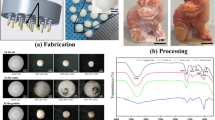Abstract
The seals made of Shoushan stone are an important treasure of traditional culture. Its surface quality has an important influence on its economic value. This study has carried out basic research on the drag polishing of irregular seals made of Shoushan stone. According to the research results of dragging polishing with hard abrasives, a solution for dragging polishing of irregular seal made of Shoushan stone with self-developed sol-gel ball tools is proposed. The process optimization of dragging polishing based on the regular Shoushan stone samples is carried out, which was applied to the dragging polishing of irregular seals made of Shoushan stone. It was found that the surface roughness was reduced from 1132 ± 62 to 287 ± 38 nm and that the gloss increased from 6.0 ± 1.9 to 34.8 ± 4.3gu. The research results show that drag polishing based on the self-developed sol-gel ball tool is a highly feasible finishing process for irregular seals made of Shoushan stone. The results of this study are meaningful for the research of drag polishing for irregular components whose hardness distribution is significantly uneven.













Similar content being viewed by others
References
X. Li, M. Huang, B. Song, Y. Zou, Y. Wang, Nondestructive Discrimination of Shoushan Stone and Laos Stone Based on Raman spectroscopy and Multivariate Methods, Acta Opt. Sin. (2016).
Y. Li, R. Chen, Z. Yang, M. Lin, Y. Wang, and F. Zhao, Discussion on Several Problems of Metallogenic Geological Condition and Genesis of Shoushan Stone, J. Gemmol., 2021, 23, p 1–11.
J. Zheng, T. Chen, Y. Liu, X. Xu, C. Yao, and Z. Zhou, Gemmological Characteristic of Jinshifeng Stone Dickite from Shoushan, J. Gems Gemmol., 2022, 24, p 43–53.
P. Stacey, S. Hall, S. Stagg, F. Clegg, and C. Sammon, Raman Spectroscopy and X-ray Diffraction Responses When Measuring Health-Related Micrometre and Nanometre Particle Size Fractions of Crystalline Quartz and the Measurement of Quartz in Dust Samples from the Cutting and Polishing of Natural and Artificial Stones, Raman Spectroscopy, 2021, 45, p 1095–1107.
G. Wang, Y. Wang, and Z. Xu, Modeling and Analysis of the Material Removal Depth for Stone Polishing, J. Mater. Process. Technol., 2009, 209, p 2453–2463.
E. Alagha, W. Alotaibi, M. Maghrbil et al., Effect of Different Finishing and Polishing Techniques on Surface Roughness of Two Universal Nanohybrid Composite Resin, Macedonian J. Med. Sci., 2020, 8, p 182–218.
T. Segreto, and R. Teti, Machine Learning for in-Process End-Point Detection in Robot-Assisted Polishing Using Multiple Sensor Monitoring, Int. J. Adv. Manuf. Technol., 2019, 103, p 4173–4187.
L. Pilný, and G. Bissacco, Development of on the Machine Process Monitoring and Control Strategy in Robot Assisted Polishing, CIRP Ann. - Manuf. Technol., 2015, 64, p 313–316.
C. Jiang, J. Huang, Z. Jiang, D. Qian, and X. Hong, Estimation of Energy Savings When Adopting Ultrasonic Vibration-Assisted Magnetic Compound Fluid Polishing, Int. J. Precis. Eng. Manuf. Technol., 2019, 8, p 1–11.
A. Jg, L.B. Chao, B. Zg, A. Yr, A. Xx, L.A. Chen, and X. Yi, Softness Abrasive Flow Polishing Method Using Constrained Boundary Vibration, Powder Technol., 2021, 382, p 173–187.
D.A. Beatriz, M. Marta, T. Roberto, and R. Eva, Analysis of Force Signals for the Estimation of Surface Roughness during Robot-Assisted Polishing, Materials (Basel)., 2018, 11, p 1438.
M. Kumar, H. Yadav, A. Kumar, M. Das, An Overview of Magnetorheological Polishing Fluid Applied in Nano-Finishing of Components, J. Micromanufacturing. (2021) 251659842110081.
T. Yu, X. Guo, Z. Wang, P. Xu, and J. Zhao, Effects of the Ultrasonic Vibration Field on Polishing Process of Nickel-Based Alloy Inconel718, J. Mater. Process. Technol., 2019, 273, p 116228.
R.P. Zeilmann, and C. Zanella, PCD Coating Polishing Effect on the Tool Wear in High-Speed Milling of Graphite, Int. J. Adv. Manuf. Technol., 2020, 108, p 2579–2593.
I. Malkorra, F. Salvatore, J. Rech, P. Arrazola, J. Tardelli, and A. Mathis, Influence of Lubrication Condition on the Surface Integrity Induced During Drag Finishing, Procedia CIRP, 2020, 87, p 245–250.
Fu. Youzhi, Wang Xuanping, Gao Hang, Wei Haibo, and Li. Shichong, Blade Surface Uniformity of Blisk Finished by Abrasive Flow Machining, Int. J. Adv. Manuf. Technol., 2016, 84, p 1725–1735.
O. Hronek, M. Zetek, T. Baka, and P. Adámek, Influences of Holders Speed on the Cutting Edge during Drag Finishing, Manuf. Technol., 2016, 16, p 933–939.
A. Kacaras, J. Gibmeier, F. Zanger, and V. Schulze, Influence of Rotational Speed on Surface States After Stream Finishing, Procedia CIRP, 2018, 71, p 221–226.
M. Barletta, F. Pietrobono, G. Rubino, and V. Tagliaferri, Drag Finishing of Sensitive Workpieces with Fluidized Abrasives, J. Manuf. Process., 2014, 16, p 494–502.
Z. Frederik, K. Andreas, N. Patrick, and S. Volker, Optimization of the Stream Finishing Process for Mechanical Surface Treatment by Numerical and Experimental Process Analysis - ScienceDirect, CIRP Ann., 2019, 68, p 373–376.
E. Uhlmann, A. Dethlefs, and A. Eulitz, Investigation of Material Removal and Surface Topography Formation in Vibratory Finishing, Procedia Cirp., 2014, 14, p 25–30.
I. Malkorra, H. Souli, F. Salvatore, P. Arrazola, J. Rech, M. Cici, and J. Rolet, Modeling of Drag Finishing—Influence of Abrasive Media Shape, J. Manuf. Mater. Process., 2021, 5(2), p 41.
I. Malkorra, F. Salvatore, P. Arrazola, and J. Rech, The Influence of the Process Parameters of Drag Finishing on the Surface Topography of Aluminium Samples, CIRP J. Manuf. Sci. Technol., 2020, 31, p 200–209.
Acknowledgments
The authors gratefully acknowledge financial support by National Natural Science Foundation of China (U1805251).
Author information
Authors and Affiliations
Corresponding author
Additional information
Publisher's Note
Springer Nature remains neutral with regard to jurisdictional claims in published maps and institutional affiliations.
Rights and permissions
About this article
Cite this article
Chen, S., Lu, J., Wang, J. et al. Research on the Drag Polishing of Irregular Seals Based on the Self-Developed Sol-Gel Ball Tools. J. of Materi Eng and Perform 32, 4229–4236 (2023). https://doi.org/10.1007/s11665-022-07384-1
Received:
Revised:
Accepted:
Published:
Issue Date:
DOI: https://doi.org/10.1007/s11665-022-07384-1




